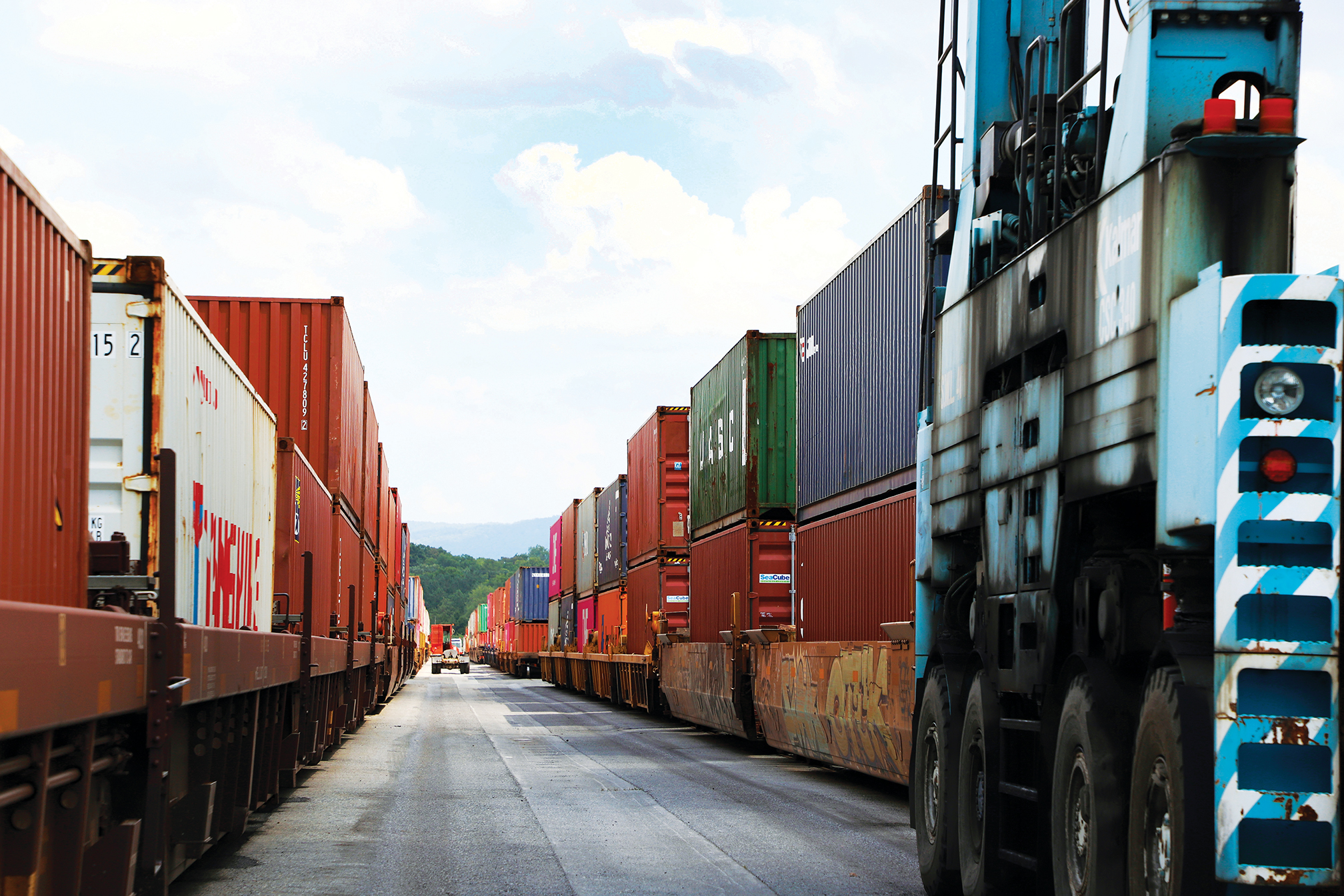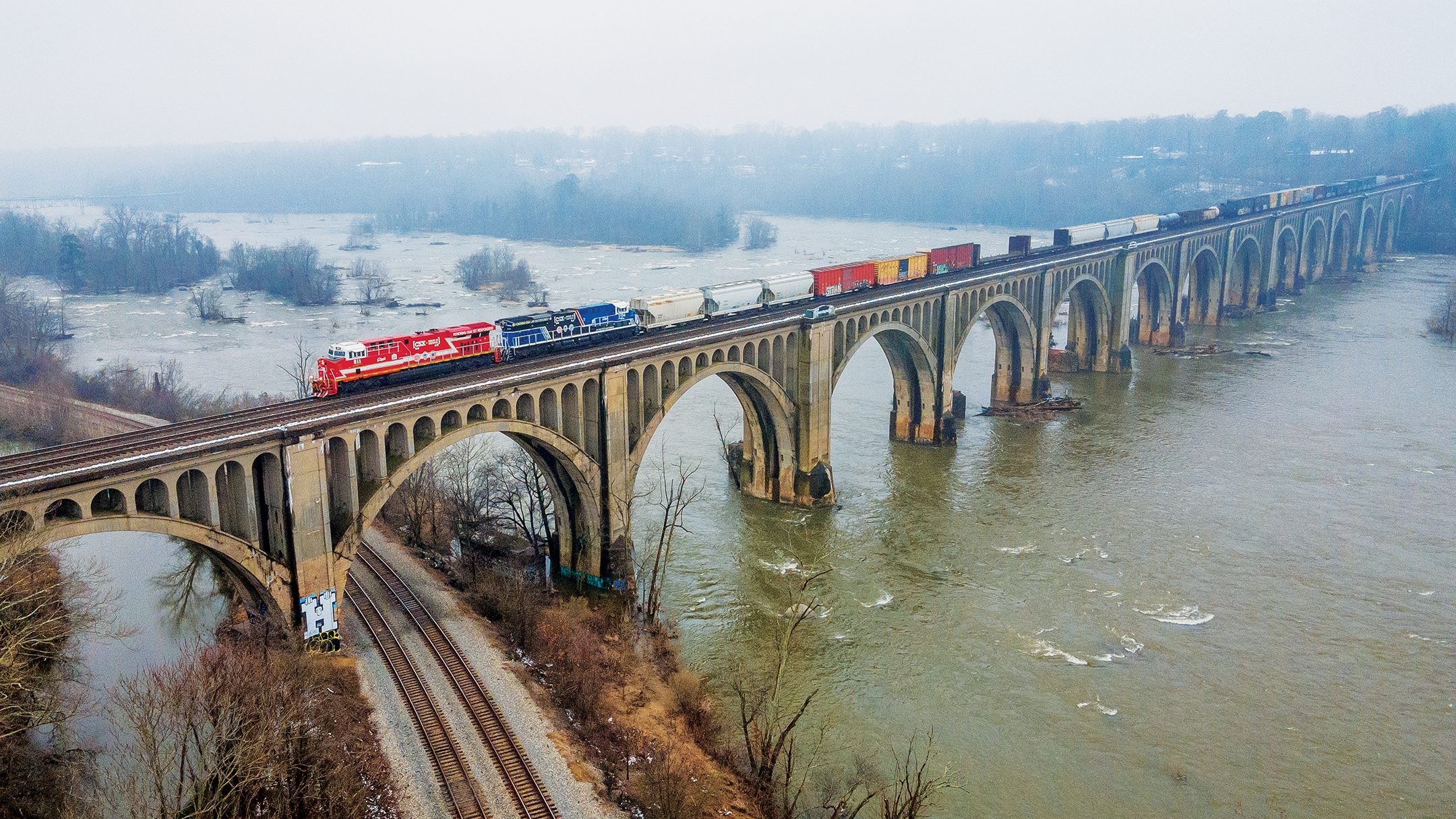‘Reimagining the Art of the Possible’
Exploring the possibilities of intermodal transport in Virginia
If you imagine timelines as train tracks and key events as moments when tracks converge, this is a pivotal time for rail in Virginia.
On July 29, the largest rail operator in the United States, Union Pacific Railroad, announced it was buying Norfolk Southern Corporation one of two freight rail operators in the Commonwealth (along with CSX Transportation) and a major operator in 22 states east of the Mississippi River.
If the U.S. Surface Transportation Board approves the purchase (after a review expected to take about two years), the deal would erase a bottleneck that forces railroad operators on either side of the Mississippi to stop and transfer cargo to another operator.
“Today, freight moving across the country often requires interchanges between railroads, which introduce delays, increased complexity, and added cost,” a Norfolk Southern representative wrote in an email. “By creating a unified network, we would remove these friction points, resulting in faster, more predictable service.”
In a new rail network that would operate in 43 of the 48 contiguous American states, the Commonwealth is positioned to become a key node. Virginia has a skilled workforce, a central location on the East Coast, and a strong port infrastructure that includes the deepest, widest port on the East Coast.
Union Pacific CEO Jim Vena agreed, saying, “Imagine cargo arriving at The Port of Virginia — whether electronics, textiles, or agricultural goods — moving seamlessly across the country to inland markets and West Coast destinations without delay.”
The proposed deal would create America’s first transcontinental railroad under a single entity and comes months after Virginia began studying how to boost its capacity to handle freight more efficiently in a tumultuous era. Freight rail in the U.S. hasn’t fully recovered from the hit it took during the COVID-19 pandemic. Wars in Ukraine and along the Red Sea have disrupted supply chains for American businesses that depend on trains and trucks to transport raw materials, components, and finished goods from ports, while tariffs imposed by the Trump administration have further complicated logistics planning.
“Global disruptions have prompted many companies to rethink their supply chains and bring production closer to home,” a CSX spokesperson wrote in an email. The representative added, “We’re facing a different world than what we were just a few years ago. Supply chains, policy, and consumer behavior are shifting rapidly. Virginia’s rail infrastructure — and CSX’s role within it — remains a competitive asset.”
Exploring the Possibilities
One possible answer being investigated by the Commonwealth: building intermodal facilities, where shipments travel between trucks and trains in containers.
“It’s reimagining the art of the possible when it comes to freight,” said Karen Jackson, a senior fellow with the Commonwealth Center for Advanced Logistics Systems (CCALS), a Petersburg-based applied research center with partners including VEDP, the Virginia Chamber of Commerce, The Port of Virginia, the University of Virginia (UVA), Virginia Commonwealth University, Virginia State University, Longwood University, and Old Dominion University.
Jackson was hired by CCALS to build collaboration between those universities, state agencies, and industry facing logistical challenges — familiar ground for her, since she served as Virginia’s secretary of technology from 2014–2019.
Her interest in intermodal was sparked by a question: What is the best way to move cargo that takes up less than a full truck? That, combined with research into intermodal sites in other countries, quickly led to follow-up questions:
- How is cargo now moved around, in, and out of Virginia?
- Are new intermodal models and/or assets emerging to improve the efficiency of movement and reduce truck traffic, noise, and pollution?
AI and related technology enable the Commonwealth to project how it might optimize its network by growing or adapting it. So CCALS has begun a three-step investigation:
- How does freight move now?
- How might changes optimize movement in the future?
- Is there enough demand among those who move freight to make new intermodal infrastructure a worthwhile investment?
To tackle the first two questions, CCALS is working with VEDP and UVA’s systems engineering program, one that has experience modeling the movement of freight at the Commonwealth’s ports.
Virginia isn’t alone in trying to adapt — other states are too. CCALS wants to help Virginia get ahead of the curve. “That becomes a competitive economic win,” Jackson said.

The Virginia Inland Port in Warren County opened in 1989 to help The Port of Virginia gain more business. The Virginia Port Authority just completed $15 million in improvements to the facility, expanding railroad track to handle larger trains.
Transcontinental Potential
She’ll find an intrigued partner in Norfolk Southern, the company said: “For Virginia, [the merger with Union Pacific] could improve the prospects for a new intermodal facility, which would serve as a strategic hub within a transcontinental system.”
Virginia has experience creating facilities that can be used by trucks, trains, and even boats. The Virginia Port Authority opened an inland port and multimodal facility in Warren County in 1989 to help compete with the Port of Baltimore, while capitalizing on road and other infrastructure advantages along the Interstate 81 corridor. The goal: move 20,000 containers a year.
The Virginia Inland Port (VIP) succeeded — its annual volume doubled its goal and drew new business. But the path to success was initially bumpy. In its first month of operation, the inland port moved just 16 containers.
That rocky start serves as a lesson for intermodal’s backers in Virginia — first make sure you have sufficient demand, and in both directions. That’s the perspective of Devon Anders, president of InterChange Group, whose warehouses include one in Front Royal that provides 48,000 square feet of dry, refrigerated, and frozen storage.
“It’s not a ‘Build it and they will come’ type of a thing,” he said. “You need to go in and secure some significant amounts of business.”
The VIP works well for big players that move so much freight they can negotiate deals with Norfolk Southern that produce savings comparable to using trucks alone.
But for an importer with lower volumes, the math doesn’t always add up.
Increasing activity at The Port of Virginia’s Norfolk facilities is great for Hampton Roads, but benefits don’t always extend very deep into Virginia. Consider the federal investment to build the Heartland Rail Corridor between Norfolk and Chicago in 2009. Doing so cut transit time from three days to two. But the first stop after Norfolk is Columbus, Ohio.
“That’s a very active line for The Port of Virginia, but those containers completely bypass Virginia,” Anders said.
Location is also a focus for John Larkin, a longtime transportation logistics analyst who now serves as a strategic advisor on transportation and logistics at Clarendon Capital. He said the VIP had a cap on growth as an intermodal location because it’s too close to the intermodal yard in Norfolk.
“You can’t generate intermodal efficiencies over 200 miles. There’s always a trucker who will do it for less,” he said.
Larkin added that the Union Pacific-Norfolk Southern deal could be a game-changer, reshaping how freight is moved nationally in ways that could make a new intermodal facility in Virginia more viable.
Until now, railroads were only willing to build intermodal for long-haul, heavy-use lanes.
“The poster child for long-haul, high-density lanes is Chicago to Los Angeles,” Larkin said. “Something like 90% of intermodal traffic flows in the 10 biggest intermodal lanes.”
Intermodal yards are expensive to operate, he said, so railroads build them only when savings over long-haul trucking outstrip those costs.

CSX Locomotive, Greater Richmond
Capitalizing on Efficiencies
If Union Pacific acquires Norfolk Southern, the balance sheet for intermodal could change by making it cheaper to move trains across the continent. Eliminating the bottleneck near the Mississippi River could cause an increase in transcontinental train freight.
“The trick, in my book, is less to focus on freight originating in Newport News and more on freight originating in Los Angeles or Seattle or Chicago, inbound to Virginia, which could be moved intermodally and then distributed locally by truck,” Larkin said.
New intermodal development makes the most sense near Interstate 95 and close to major cities and distribution centers, he said. The strongest location would be near Washington, D.C.; other strong possibilities would be close to Richmond or Roanoke.
The current rail network mostly moves finished goods made overseas from ports in double-stacked trains. The proposed merger and onshore manufacturing could reshape that network and make short hauls more viable.
“Instead of just transporting finished goods over long distances, you could be transporting raw materials, semi-finished materials, finished materials, components, subassemblies, and finished products — all within the U.S.,” Larkin said.


